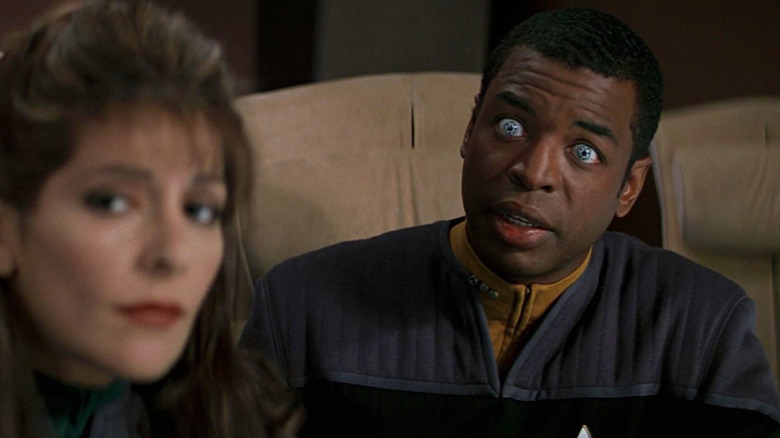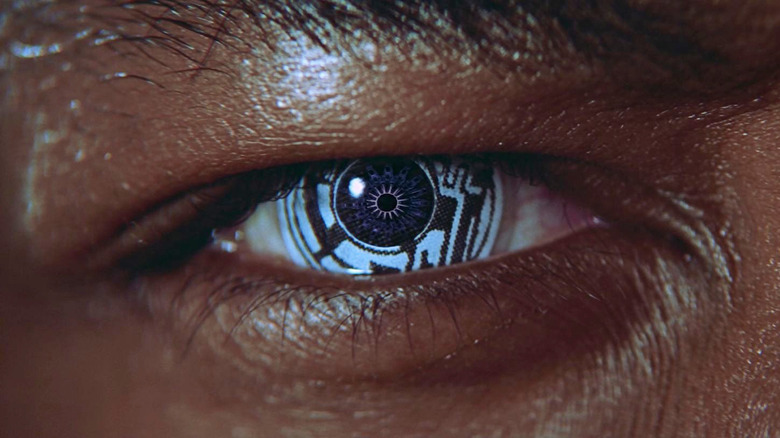Star Trek: First Contact Created Geordi's Eyeballs With A Quick Trip To Home Depot
Throughout "Star Trek: The Next Generation," the character of Geordi La Forge (LeVar Burton) wore a visor across his eyes. Geordi was blind and the visor allowed him to see. To briefly explain its operation, the visor was attached to Geordi's face at his temples, where he had small mechanical implants that reached directly into the visual cortex of his brain. The visor would pick up a wide range of optical information, mostly based on thermal patterns, and fed it directly into Geordi's brain, bypassing his eyes. It allowed Geordi to see.
Burton had to wear the visor on set every workday for seven years, and continued to wear it in the 1994 film "Star Trek Generations." Many appreciated that "Star Trek" featured a visually impaired character, but moreso that Geordi's blindness was never an issue or a plot point. His disability was incidental, and that was great.
But when the time came to make "Star Trek: First Contact," it was time for Geordi to get his first contacts.
Burton, you see, was tired of wearing his visor on set. In contrast to its fictional function, the actual costume piece blocked a great deal of Burton's vision. For "First Contact," the filmmakers had mercy on Burton and wrote that Geordi got upgraded, eyeball-shaped appliances installed. The costume visor was replaced with contact lenses.
Geordi's new mechanical eyes were equipped with a "zoom" function that operated like a camera lens. A closeup of his eye showed that his pupils mechanically opened and closed. It was a pretty neat upgrade.
To achieve the "eyeball zoom" effect, visual effect supervisor David Takemura required pretty simple parts. According to a 2016 oral history in The Hollywood Reporter, he merely picked up a shower appliance at his local Home Depot.
Geordi's first contacts
The irises of Geordi's mechanical eyes were merely a part of Burton's contacts. The extreme closeup of his eye, however, required some special effects to achieve the moving pupils. The effect was digital, as were most of the larger visual effects in the movie, but the digital images were scanned from a very plain piece of everyday kitchen equipment. Takemura explained:
"There's a little gag where you see his now-bionic eyes. His bionic pupils rotating. In this high-tech, visual effects world that we live in, that was decidedly low-tech. It was actually a crystal faucet shower handle that I found at Home Depot. I just took some still photographs of it and I worked with one of the compositing artists at Pacific Ocean Post. It was just rotating that crystal shower faucet handle and doing some expansions of his iris to make it look mechanical."
This is what we call movie magic. Use whatever elements are at your disposal to create outlandish, interesting visuals.
Many Trekkies will be able to tell you that the transporter effect from the original series was a film clip of a bubbling glass of seltzer superimposed over the actors. For "Next Generation," the transporters effect was upgraded to a glass of glitter, stirred quickly and filmed in closeup.
Perhaps a controversial view: "Star Trek" has always been better when it was butting up against its limited budget. The showrunners had to get creative with their stories when they didn't have the budget to do big, outsize sagas every week. And when it came to high-tech, futuristic equipment, they had to find creative ways to repurpose existing machines or build new ones in a jiffy.
As the Klingons say: 'u' Qun'a' quvHa'moHbogh ghot quvHa'moH.
Necessity is the mother of invention.

